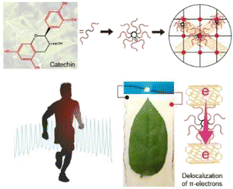An extremely transparent and multi-responsive healable hydrogel strain sensor†
Abstract
Hydrogels that are both transparent and conductive are promising materials for flexible electronics. The increase in individual conducting units always lowers their transparency, leading to limited application scope. Here, a high-performance hydrogel sensor with high transparency, as well as multi-responsive self-healing ability, is developed through in situ polymerization using an ultra-low content (1.08 × 10−4 wt%) of carboxyl multi-walled carbon nanotubes (c-MWCNTs) and self-assembled catechin nanoparticles (NPs) as the electron bridging agents. Due to the substantial interfacial interactions, including π–π and hydrogen bonds, and the markedly decreased contact resistance between c-MWCNTs, the target hydrogel exhibits high transparency of 90% at 550 nm and good conductivity of 0.19 S m−1. Besides, the target hydrogel offers a series of smart characteristics, including outstanding biocompatibility, remarkable notch insensitivity, strong adhesion, multi-responsive self-healing property and electromechanical stability ranging from 0.1% to a high strain of 900%. These prominent performance merits make this emerging hydrogel sensor a highly potential candidate for next-generation flexible and wearable electronics.



 Please wait while we load your content...
Please wait while we load your content...